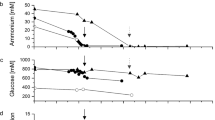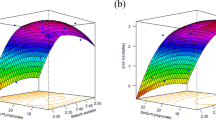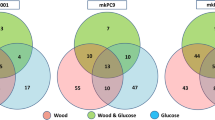Abstract
THE ability of cellulose-forming species of Acetobacter to produce from glucose a mixture of melibiose, cellobiose, cellotriose, cellotetraose and fructose, together with higher oligosaccharides some of which yield fructose on hydrolysis, has been reported in recent communications1–3. We have now examined the behaviour, in comparable conditions, of Acetobacter aceti N.C.I.B. 8554, Acetobacter rancens N.C.I.B. 7214, Acetobacter acidum-mucosum N.C.I.B. 8133, and Acetobacter acetosum var. nairobiense N.C.I.B. 7212, none of which produces cellulose. A. aceti was grown in a medium containing (gm./l.): (NH4)2SO4, 3; MgSO4.7H2O, 2; KH2PO4, 3; glucose, 30. The same ingredients with addition (gm./l.) of: DL-alanine, 0.1; asparagine, 0.1; calcium D-pantothenate, 0.002; riboflavin, 0.002 and biotin, 0.0003, were employed to make up the medium for the three other species. These media were dispensed in volumes of 200 ml. in sixteen Glaxo flasks, four flasks for each species. After inoculation and incubation for 10 days at 28° C. the contents of each set of four flasks were Seitz-filtered and concentrated to about 50 ml. in presence of a little barium carbonate in vacuo at 35°. Each concentrate was filtered and treated in the following manner in all four cases. It was added to a column (4.5 cm. diameter) filled with a charcoal–‘Celite’ (50 : 50, w/w) mixture. The column was eluted with water (5 l.) and then with aqueous ethanol solutions containing, respectively, 5, 15, 20 and 35 per cent (v/v) of ethanol. The aqueous ethanolic eluates were combined (4 l.), concentrated under low pressure at 35° C. to 500 ml. and treated successively with ‘Zeo-Karb 225’ (H+ form) and ‘De-Acidite E’ (OH− form).
This is a preview of subscription content, access via your institution
Access options
Subscribe to this journal
Receive 51 print issues and online access
$199.00 per year
only $3.90 per issue
Buy this article
- Purchase on Springer Link
- Instant access to full article PDF
Prices may be subject to local taxes which are calculated during checkout
Similar content being viewed by others
References
Wright, H. B., and Walker, T. K., Chem. and Indust., 18 (1955).
Walker, T. K., and Wright, H. B., Arch. Biochem. Biophys., 69, 362 (1957).
Steel, R., and Walker, T. K., Nature, 180, 201 (1957).
Bayly, R. J., and Bourne, E. J., Nature, 171, 385 (1953).
Bacon, J. S. D., and Bell, D. J., J. Chem. Soc., 2528 (1953).
Bacon, J. S. D., Biochem. J., 57, 320 (1954).
Feingold, D. S., Avigad, G., and Hestrin, S., Biochem. J., 64, 340, 351 (1956).
Author information
Authors and Affiliations
Rights and permissions
About this article
Cite this article
KHAN, A., PELLEGRINO, D. & WALKER, T. Detection of Gentiobiose and Sophorose in Cultures of Certain Micro-organisms growing in Defined Glucose-containing Media. Nature 183, 682–683 (1959). https://doi.org/10.1038/183682a0
Issue Date:
DOI: https://doi.org/10.1038/183682a0
This article is cited by
-
Variability of acetic acid bacteria
Antonie van Leeuwenhoek (1962)
Comments
By submitting a comment you agree to abide by our Terms and Community Guidelines. If you find something abusive or that does not comply with our terms or guidelines please flag it as inappropriate.



